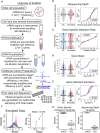Enhancing biological signals and detection rates in single-cell RNA-seq experiments with cDNA library equalization
- PMID: 34850101
- PMCID: PMC8789062
- DOI: 10.1093/nar/gkab1071
Enhancing biological signals and detection rates in single-cell RNA-seq experiments with cDNA library equalization
Abstract
Considerable effort has been devoted to refining experimental protocols to reduce levels of technical variability and artifacts in single-cell RNA-sequencing data (scRNA-seq). We here present evidence that equalizing the concentration of cDNA libraries prior to pooling, a step not consistently performed in single-cell experiments, improves gene detection rates, enhances biological signals, and reduces technical artifacts in scRNA-seq data. To evaluate the effect of equalization on various protocols, we developed Scaffold, a simulation framework that models each step of an scRNA-seq experiment. Numerical experiments demonstrate that equalization reduces variation in sequencing depth and gene-specific expression variability. We then performed a set of experiments in vitro with and without the equalization step and found that equalization increases the number of genes that are detected in every cell by 17-31%, improves discovery of biologically relevant genes, and reduces nuisance signals associated with cell cycle. Further support is provided in an analysis of publicly available data.
© The Author(s) 2021. Published by Oxford University Press on behalf of Nucleic Acids Research.
Figures





Similar articles
-
Single-Cell Transcriptomics of Immune Cells: Cell Isolation and cDNA Library Generation for scRNA-Seq.Methods Mol Biol. 2020;2184:1-18. doi: 10.1007/978-1-0716-0802-9_1. Methods Mol Biol. 2020. PMID: 32808214
-
Normalization of Single-Cell RNA-Seq Data.Methods Mol Biol. 2021;2284:303-329. doi: 10.1007/978-1-0716-1307-8_17. Methods Mol Biol. 2021. PMID: 33835450
-
Dimensionality Reduction of Single-Cell RNA-Seq Data.Methods Mol Biol. 2021;2284:331-342. doi: 10.1007/978-1-0716-1307-8_18. Methods Mol Biol. 2021. PMID: 33835451
-
Data normalization for addressing the challenges in the analysis of single-cell transcriptomic datasets.BMC Genomics. 2024 May 6;25(1):444. doi: 10.1186/s12864-024-10364-5. BMC Genomics. 2024. PMID: 38711017 Free PMC article. Review.
-
Identifying cell types to interpret scRNA-seq data: how, why and more possibilities.Brief Funct Genomics. 2020 Jul 29;19(4):286-291. doi: 10.1093/bfgp/elaa003. Brief Funct Genomics. 2020. PMID: 32232401 Review.
Cited by
-
The use of base editing technology to characterize single nucleotide variants.Comput Struct Biotechnol J. 2022 Mar 31;20:1670-1680. doi: 10.1016/j.csbj.2022.03.031. eCollection 2022. Comput Struct Biotechnol J. 2022. PMID: 35465164 Free PMC article. Review.
-
Effect of CB2 Stimulation on Gene Expression in Pediatric B-Acute Lymphoblastic Leukemia: New Possible Targets.Int J Mol Sci. 2022 Aug 3;23(15):8651. doi: 10.3390/ijms23158651. Int J Mol Sci. 2022. PMID: 35955786 Free PMC article.
-
Analysis of Single-Cell RNA-seq Data.Methods Mol Biol. 2023;2629:95-114. doi: 10.1007/978-1-0716-2986-4_6. Methods Mol Biol. 2023. PMID: 36929075
-
Studying stochastic systems biology of the cell with single-cell genomics data.Cell Syst. 2023 Oct 18;14(10):822-843.e22. doi: 10.1016/j.cels.2023.08.004. Epub 2023 Sep 25. Cell Syst. 2023. PMID: 37751736 Free PMC article. Review.
-
Data-driven selection of analysis decisions in single-cell RNA-seq trajectory inference.bioRxiv [Preprint]. 2023 Dec 19:2023.12.18.572214. doi: 10.1101/2023.12.18.572214. bioRxiv. 2023. Update in: Brief Bioinform. 2024 Mar 27;25(3):bbae216. doi: 10.1093/bib/bbae216. PMID: 38187768 Free PMC article. Updated. Preprint.
References
-
- Svensson V., Vento-Tormo R., Teichmann S.A.. Exponential scaling of single-cell RNA-seq in the past decade. Nat. Protoc. 2018; 13:599–604. - PubMed
-
- Finak G., McDavid A., Yajima M., Deng J., Gersuk V., Shalek A.K., Slichter C.K., Miller H.W., McElrath M.J., Prlic M.et al.. MAST: a flexible statistical framework for assessing transcriptional changes and characterizing heterogeneity in single-cell RNA sequencing data. Genome Biol. 2015; 16:278. - PMC - PubMed
Publication types
MeSH terms
Grants and funding
LinkOut - more resources
Full Text Sources
Molecular Biology Databases

